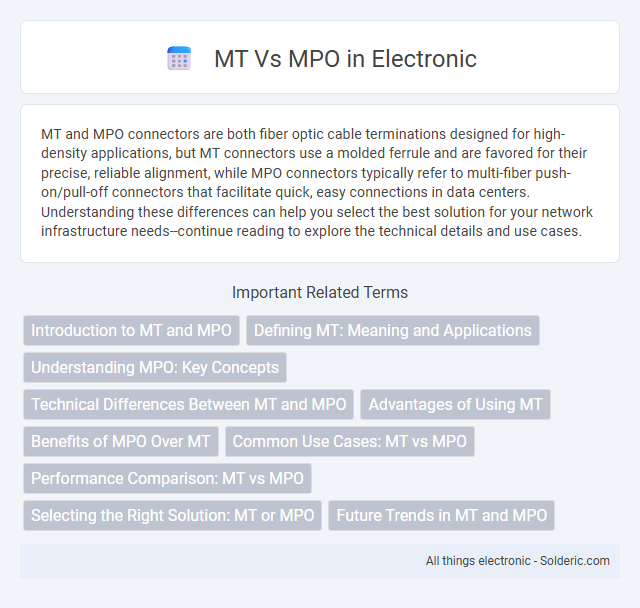MT and MPO connectors are both fiber optic cable terminations designed for high-density applications, but MT connectors use a molded ferrule and are favored for their precise, reliable alignment, while MPO connectors typically refer to multi-fiber push-on/pull-off connectors that facilitate quick, easy connections in data centers. Understanding these differences can help you select the best solution for your network infrastructure needs--continue reading to explore the technical details and use cases.
Comparison Table
| Aspect | MT (Machine Translation) | MPO (Multi-Path Optimization) |
|---|---|---|
| Definition | Automated translation of text using AI algorithms. | Optimization technique using multiple paths to improve performance. |
| Primary Use | Language translation in software, websites, and apps. | Network routing, data processing, and system efficiency improvements. |
| Technology | Neural networks, statistical models, and linguistic rules. | Graph theory, pathfinding algorithms, and load balancing. |
| Goal | Accurate, fast, and context-aware text translation. | Maximize throughput and minimize latency via multiple routes. |
| Applications | Global communication, localization, content accessibility. | Telecommunications, data center networking, logistics. |
| Output | Translated text in target language. | Optimized paths and resource allocation for systems. |
Introduction to MT and MPO
MT (Mechanical Transfer) connectors and MPO (Multi-fiber Push-On) connectors are critical components in high-speed fiber optic networks, designed to optimize data transmission. MT connectors typically house multiple fibers in a compact ferrule, supporting efficient mass fusion splicing, while MPO connectors feature a push-pull mechanism for easy installation and secure multi-fiber connections. Understanding the differences in their mechanical design and application helps enhance Your network's performance and scalability.
Defining MT: Meaning and Applications
MT connectors, known as Mechanical Transfer connectors, are designed for high-density fiber optic applications, enabling efficient alignment of multiple fibers within a single ferrule. They facilitate rapid and precise multi-fiber connections, commonly used in data centers and telecommunications networks to support high-speed data transmission. MT technology is essential in environments demanding scalable and reliable fiber optic interconnections.
Understanding MPO: Key Concepts
MPO (Multi-fiber Push-On) connectors enable high-density fiber optic connections by supporting multiple fibers, typically 12 or 24, in a single interface, enhancing network scalability and performance. Designed for rapid deployment in data centers, MPO connectors facilitate efficient parallel optics transmission and simplified fiber management compared to traditional MT (Mechanical Transfer) connectors. Understanding MPO technology involves recognizing its LC-compatible ferrule design, polarity configurations, and its vital role in enabling ultra-high-speed data communication through multi-fiber cabling systems.
Technical Differences Between MT and MPO
MT connectors use multiple small-diameter fibers aligned in a single row within a single ferrule, while MPO connectors have fibers arranged in a rectangular array, typically 12 or 24 fibers per ferrule. MT connectors rely on precision guide pins for alignment, offering high-density and low insertion loss, whereas MPO connectors are designed for quick unplugging and plugging with a more modular approach. Understanding these technical differences helps you select the best connector for high-speed data transmission and cabling efficiency.
Advantages of Using MT
MT (Mechanical Transfer) connectors offer significant advantages over MPO (Multi-Fiber Push-On) connectors, including simpler installation and lower cost, making them ideal for straightforward fiber optic cabling projects. Their compact design ensures compatibility with high-density environments while maintaining easy field termination without specialized tools. You benefit from enhanced flexibility and reduced downtime due to the straightforward maintenance MT connectors provide.
Benefits of MPO Over MT
MPO connectors offer superior fiber density compared to MT connectors, enabling higher port counts and more efficient use of space in data centers and telecom networks. Your network benefits from easier installation and maintenance due to MPO's standardized multi-fiber design, which reduces complexity and downtime. Enhanced scalability and future-proofing make MPO a preferred choice for high-speed applications like 40G and 100G Ethernet.
Common Use Cases: MT vs MPO
MT connectors are commonly used in high-density ribbon fiber applications, such as data centers and telecommunications where space savings and mass termination are critical. MPO connectors are widely deployed in high-speed network environments like enterprise LANs and data centers for parallel optics transmission supporting 40G, 100G, and beyond. Selecting between MT and MPO depends on Your need for either ribbon fiber termination or multi-fiber parallel optical connectivity.
Performance Comparison: MT vs MPO
MT and MPO fiber optic connectors differ significantly in performance, with MPO connectors typically offering higher density and better scalability for network applications, supporting up to 72 fibers per connector compared to MT's 12 or 24 fibers. MPO connectors generally provide lower insertion loss and improved return loss, enhancing signal quality and reliability in high-speed data transmissions such as 40G and 100G Ethernet. Your choice between MT and MPO should consider bandwidth requirements, connector durability, and deployment environment to optimize network performance.
Selecting the Right Solution: MT or MPO
Selecting the right solution between MT and MPO connectors depends on your network requirements for density and speed. MT connectors are ideal for high-density fiber applications, providing compact, multi-fiber connectivity with excellent alignment precision. MPO connectors offer flexibility and scalability in multisource environments, supporting up to 12 or 24 fibers and facilitating rapid deployment in data centers and telecom networks.
Future Trends in MT and MPO
Future trends in MT (Mechanical Termination) and MPO (Multi-fiber Push On) connectors highlight increasing demand for higher-density fiber optic solutions and enhanced scalability in data centers. Innovations are driving improved performance, reduced insertion loss, and easier deployment, enabling your network infrastructure to support next-generation 400G and 800G Ethernet standards. Advancements in MPO technology focus on automation and ruggedization to meet growing requirements for efficient, high-speed data transmission in hyperscale and edge computing environments.
MT vs MPO Infographic

 solderic.com
solderic.com